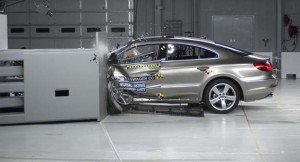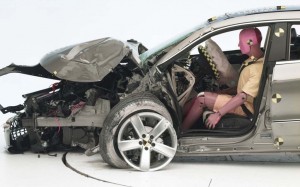
The Acura TL was one of only two among 11 compact luxury sedans to earn a "good" rating in the new test.
Hoping to push the industry to further improve the safety of tomorrow’s cars, an influential insurance trade group has launched a new partial front test designed to simulate a very common real world crash situation.
And of the 11 new compact luxury sedans put through the test by the Insurance Institute for Highway Safety, or IIHS, only two earned a “good” rating while one other was rated “acceptable.”
Explaining the need for the new, partial overlap test, IIHS President Adrian Lund said, “Nearly every new car performs well in other frontal crash tests conducted by the institute and the federal government, but we still see more than 10,000 deaths in frontal crashes each year.”
The new IIHS test differs markedly from those currently used – and from the standards manufacturers are required to meet under federal law. Nonetheless, it is designed to simulate the sort of frontal collisions that are responsible for a large share of those deaths, according to Lund.
As part of the test a vehicle is driven into a 5-foot-tall rigid barrier at 40 mph, but only 25% of the driver’s side of the vehicle actually makes contact with the barrier. The test simulates what often when two vehicles clip one another on a local road where one driver might inadvertently cross the center line, or where a vehicle hits a tree or utility pole.
Only the Acura TL and Volvo S60 passed the test with a “good” rating. The Infiniti G was rated “acceptable.”
Those vehicles that failed the test included the Acura TSX, BMW 3-Series, Lincoln MKZ and Volkswagen CC, all rated “marginal,” while the Audi A4, Lexus ES 350, Lexus IS 250/350 and Mercedes-Benz C-Class were all rated “poor.”
The Volvo used several methods to reinforce the passenger compartment safety cage, including upper rails, noted Lund. At the other extreme, the VW CC performed so poorly that the driver’s door was completely sheared off its hinges, the first time that has occurred in IIHS testing.
Safety experts credit tests run by both federal regulators and the IIHS with prompting automakers to improve the crashability of their vehicles – something that has played out in a sharp decline in highway fatalities in recent years. In vehicles no more than three years old, the number of fatalities from frontal crashes, in particular, has declined by 55% since 2001.
A statement from the National Highway Traffic Safety Administration praised the new tests, suggesting the agency “looks forward to seeing how vehicle manufacturers respond to this new rating criteria and the safety benefits it will yield.”

